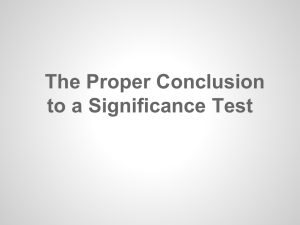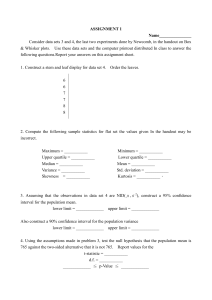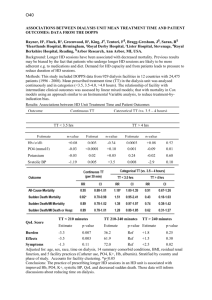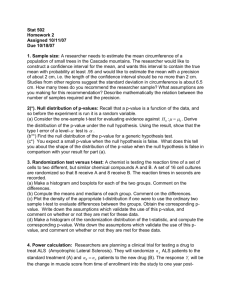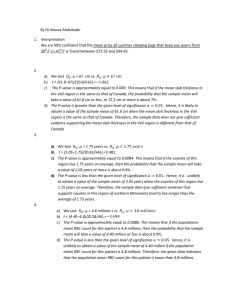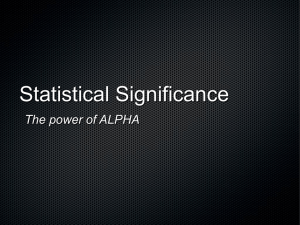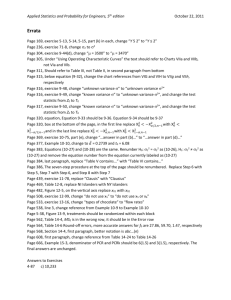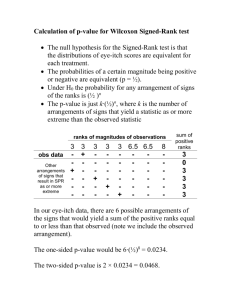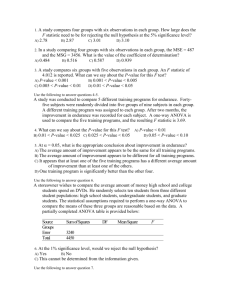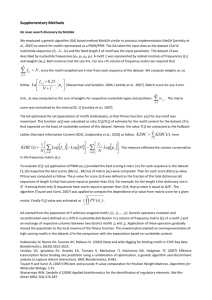macro-ape manual v4
advertisement
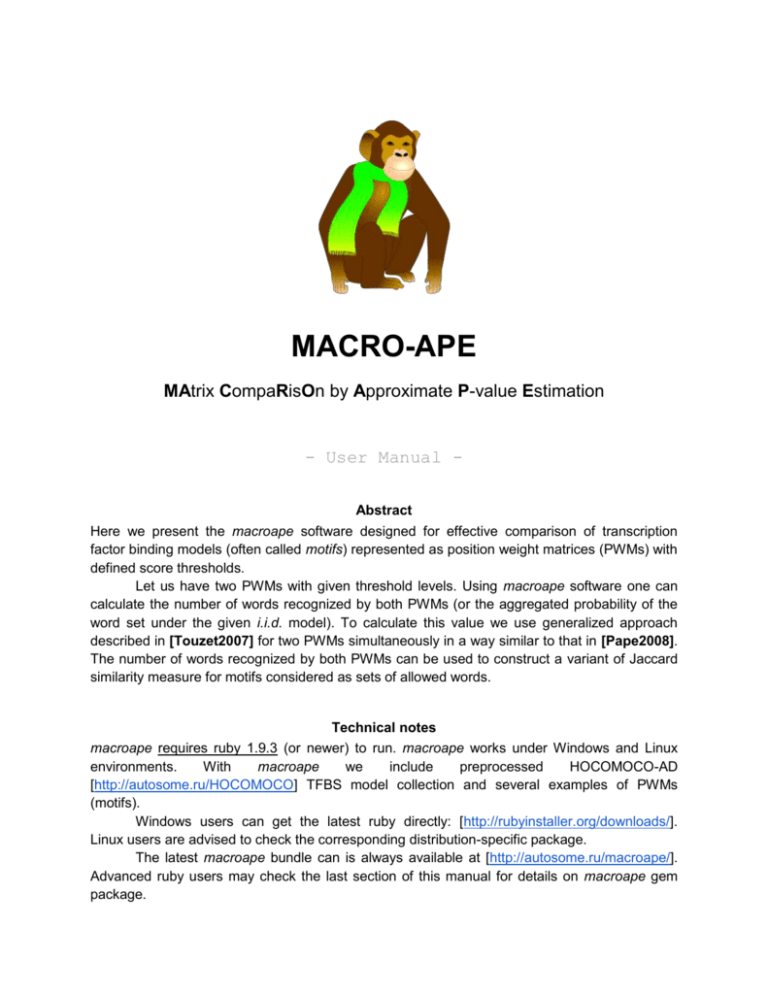
MACRO-APE
MAtrix СompaRisOn by Approximate P-value Estimation
- User Manual Abstract
Here we present the macroape software designed for effective comparison of transcription
factor binding models (often called motifs) represented as position weight matrices (PWMs) with
defined score thresholds.
Let us have two PWMs with given threshold levels. Using macroape software one can
calculate the number of words recognized by both PWMs (or the aggregated probability of the
word set under the given i.i.d. model). To calculate this value we use generalized approach
described in [Touzet2007] for two PWMs simultaneously in a way similar to that in [Pape2008].
The number of words recognized by both PWMs can be used to construct a variant of Jaccard
similarity measure for motifs considered as sets of allowed words.
Technical notes
macroape requires ruby 1.9.3 (or newer) to run. macroape works under Windows and Linux
environments.
With
macroape
we
include
preprocessed
HOCOMOCO-AD
[http://autosome.ru/HOCOMOCO] TFBS model collection and several examples of PWMs
(motifs).
Windows users can get the latest ruby directly: [http://rubyinstaller.org/downloads/].
Linux users are advised to check the corresponding distribution-specific package.
The latest macroape bundle can is always available at [http://autosome.ru/macroape/].
Advanced ruby users may check the last section of this manual for details on macroape gem
package.
All tools in macroape bundle provide detailed help messages if executed without
parameters (or if "-h" or "--help" is specified in the command line).
Introduction
Тypical methods of comparing PWMs are based on direct comparison of elements, for instance
by comparing matrices column by column (where different columns correspond to different
positions of a binding site). On the other hand, in applications PWM is used as TFBS model to
identify “binding sites” by scanning a given text and identifying words having PWM scores no
less than a preselected threshold. So, in reality a TFBS model is related to the set of words
scoring no less than the given threshold for the given PWM. It is desirable to construct a
similarity measure for TFBS models according to the similarity between word sets recognized by
the matrices with given thresholds, rather than according to similarity between matrices per se.
Moreover, comparison-by-elements strategy requires the matrices to have algebraically
comparable values (either frequencies or specifically scaled weights) which is not necessary if
sets of recognized TFBS are compared.
Here we present a similarity measure which directly accounts for the similarity of
recognized word sets. This measure does not require PWM elements to be algebraically
comparable and so it can be used to compare weight matrices constructed by different
normalization / conversion strategies.
Let us have a position weight matrix of length w. The whole set of ACGT-alphabet words
of length w will be called the dictionary of size N=4w. For a fixed threshold level t one can
calculate the fraction of the dictionary (i.e. the number of words n) scoring no less than the
threshold. We will call the value of n / N as the motif P-value.
Suppose we have 2 PWMs m1, m2 of length w and some P-value levels p1, p2. For m1
and m2 we can estimate the thresholds t1 and t2 corresponding to p1, p2. Having PWMs with the
corresponding thresholds we can estimate the fraction f of the dictionary recognized by both
models, i.e. the size of the set of words scoring no less than t1 on m1 and no less than t2 on m2.
Moreover one can construct the Jaccard index J = A∩B / AUB where A and B are sets
of words recognized by m1 and m2 with the thresholds t1 and t2. If necessary one also can
construct a Jaccard distance as d(A,B) = 1 - J.
In the general case we have two PWMs of different widths, unknown optimal mutual
alignment and orientation. For each possible alignment shift and orientation the matrices can be
extended to the same length by adding zero-columns (not affecting either score or threshold)
and then compared as the two models of the same width. Then one can determine the optimal
shift and orientation by selecting the case with the highest Jaccard similarity. More formal and
detailed explanation can be found in the corresponding macroape paper.
Basic tools
motifs "pat"-format description
All tools described below use the following matrix file format (each binding site position
corresponds to separate line):
some_header
pos1_A_weight pos1_C_weight pos1_G_weight pos1_T_weight
..
posw_A_weight posw_C_weight posw_G_weight posw_T_weight
The number of the lines corresponds to the PWM width. Some real-life examples are provided
within the macroape package.
All tools except preprocess_collection print results into stdout (standard output).
preprocess_collection yields result to the output file. preprocess_collection and
scan_collection print progress information to the stderr stream.
Output generally consists of two line types. Lines starting with ‘#’ character (comment) show
input parameter values and descriptions. The results are presented in non-commented lines.
find_threshold.rb
Stand-alone tool to search for the threshold corresponding to a given P-value for a given PWM.
This scripts requires a PWM and a P-value as input and returns a threshold for which the set of
words scoring with this PWM above the given threshold has the aggregated probability equal to
the given P-value. The program can process a set of P-values, and return a set of thresholds.
This tool implements the algorithm similar to that implemented in TFM-Pvalue software of Helen
Touzet [http://bioinfo.lifl.fr/TFM/TFMpvalue/] with fixed discretization level (see "PWM
discretization" section below).
Example (motif file KLF4_f2.pat, P-value of 0.001 and 0.0005):
ruby find_threshold.rb motifs/KLF4_f2.pat 0.001 0.0005
Output:
# V: discretization value
# PB: P-value boundary
# V = 10000
# PB = lower
#
# P: requested P-value
# AP: actual P-value
# W: number of recognized words
# T: threshold
# P
AP
W
T
0.0005 0.000499725341796875
524.0
0.001
0.00099945068359375
1048.0
5.24071
4.17189
For a more precise result one can use "-d" command line key like "-d 100000" to explicitly set
the discretization level for PWM elements (see the "PWM discretization" section below for
details). Тhe discretization level of 105 corresponds to the precision of PWM elements up to 5
decimal places. A larger number of decimal places results in the increased precision and
computational time. The default setting of 10000 gives reasonable "time-precision" tradeoff.
NOTE! By default find_threshold looks for threshold large enough to obtain P-value not
greater than requested (lower boundary for P-value).
find_pvalue.rb
A stand-alone tool to find the P-value corresponding to a given threshold level for a given PWM.
Example (motif file KLF4_f2.pat, thresholds of 4.1719 and 5.2403):
ruby find_pvalue.rb
motifs/KLF4_f2.pat
4.1719
5.2403
Output:
# V: discretization value
# V = 10000
#
# T: threshold
# W: number of recognized words
# P: P-value
# T
W
P
4.1719 1048.0 0.00099945068359375
5.2403 524.0
0.000499725341796875
eval_similarity.rb
Stand-alone tool to compute the similarity for two given motifs with given thresholds or given Pvalue level. Uses P-value of 0.0005 by default.
Example (rather similar motifs KLF4_f2 and SP1_f1):
ruby eval_similarity.rb motifs/KLF4_f2.pat motifs/SP1_f1.pat
Output:
#
#
#
#
#
#
#
#
#
#
#
#
#
V: discretization
P: requested P-value
PB: P-value boundary
V = 10.0
P = 0.0005
PB = upper
S: similarity
D: distance (1-similarity)
L: length of the alignment
SH: shift of the 2nd PWM relative to the 1st
OR: orientation of the 2nd PWM relative to the 1st
A1: aligned 1st matrix
# A2: aligned 2nd matrix
# W: number of words recognized by both models (model = PWM +
threshold)
# W1: number of words and recognized by the first model
# P1: P-value for the 1st matrix
# T1: threshold for the 1st matrix
# W2: number of words recognized by the 2nd model
# P2: P-value for the 2nd matrix
# T2: threshold for the 2nd matrix
S
0.24382446963092125
D
0.7561755303690787
L
11
SH
-1
OR
direct
A1
.>>>>>>>>>>
A2
>>>>>>>>>>>
W
839.0
W1
2104.0
P1
0.0005016326904296875
T1
5.8
W2
2176.0
P2
0.000518798828125
T2
5.6
Example (the same motif SP1_f1 in opposite orientations):
ruby eval_similarity.rb motifs/SP1_f1_revcomp.pat motifs/SP1_f1.pat
Output:
# V: discretization
# P: requested P-value
# PB: P-value boundary
# V = 10.0
# P = 0.0005
# PB = upper
#
# S: similarity
# D: distance (1-similarity)
# L: length of the alignment
# SH: shift of the 2nd PWM relative to the 1st
# OR: orientation of the 2nd PWM relative to the 1st
# A1: aligned 1st matrix
# A2: aligned 2nd matrix
# W: number of words recognized by both models (model = PWM +
threshold)
# W1: number of words and recognized by the first model
# P1: P-value for the 1st matrix
# T1: threshold for the 1st matrix
# W2: number of words recognized by the 2nd model
# P2: P-value for the 2nd matrix
# T2: threshold for the 2nd matrix
S
D
L
SH
OR
A1
A2
W
W1
P1
T1
W2
P2
T2
1.0
0.0
11
0
revcomp
>>>>>>>>>>>
<<<<<<<<<<<
2176.0
2176.0
0.000518798828125
5.6
2176.0
0.000518798828125
5.6
Example (significantly different motifs SP1_f1 and GABPA_f1):
ruby eval_similarity.rb motifs/SP1_f1.pat motifs/GABPA_f1.pat
Output:
# V: discretization
# P: requested P-value
# PB: P-value boundary
# V = 10.0
# P = 0.0005
# PB = upper
#
# S: similarity
# D: distance (1-similarity)
# L: length of the alignment
# SH: shift of the 2nd PWM relative to the 1st
# OR: orientation of the 2nd PWM relative to the 1st
# A1: aligned 1st matrix
# A2: aligned 2nd matrix
# W: number of words recognized by both models (model = PWM +
threshold)
# W1: number of words and recognized by the first model
# P1: P-value for the 1st matrix
# T1: threshold for the 1st matrix
# W2: number of words recognized by the 2nd model
# P2: P-value for the 2nd matrix
# T2: threshold for the 2nd matrix
S
0.005720576093936336
D
0.9942794239060637
L
14
SH
1
OR
direct
A1
>>>>>>>>>>>...
A2
.>>>>>>>>>>>>>
W
1559.0
W1
P1
T1
W2
P2
T2
139264.0
0.000518798828125
5.6
134820.0
0.0005022436380386353
4.5
Note! By default eval_similarity selects the threshold corresponding to the P-value not
less than requested (upper boundary). This is different from find_threshold which uses
lower boundary for P-value.
It is very important to select upper P-value boundary for short PWMs. In case of given
low P-values they can recognize no words at all (so the Jaccard measure may have zero
numerator and zero denominator). For reasonable threshold levels both upper and lower
boundaries produce very close similarity values.
Nevertheless, one can override this behavior with ‘--boundary lower’ option. In such a case if
any of supplied PWMs recognizes no words for a selected P-value, then similarity can not be
correctly determined and macroape will report the similarity value of -1.
This also affects the search through a model collection (see below).
NOTE! For scan_collection tool this affects only a query PWM. The same option should be
specified with preprocess_collection when preprocessing a PWM collection
eval_alignment.rb
Stand-alone tool to calculate the Jaccard index for two given motifs and a given P-value level
using predefined motif alignment. Uses P-value of 0.0005 by default.
Example (rather similar motifs KLF4_f2 and SP1_f1 at optimal alignment):
ruby eval_alignment.rb motifs/KLF4_f2.pat motifs/SP1_f1.pat -1 direct
Output:
#
#
#
#
#
#
#
#
#
#
#
#
#
#
#
#
#
#
V: discretization
P: requested P-value
PB: P-value boundary
V = 10.0
P = 0.0005
PB = upper
S: similarity
D: distance (1-similarity)
L: length of the alignment
SH: shift of the 2nd PWM relative to the 1st
OR: orientation of the 2nd PWM relative to the 1st
A1: aligned 1st matrix
A2: aligned 2nd matrix
W: number of words recognized by both models (model = PWM + threshold)
W1: number of words and recognized by the first model
P1: P-value for the 1st matrix
T1: threshold for the 1st matrix
# W2: number of words recognized by the 2nd model
# P2: P-value for the 2nd matrix
# T2: threshold for the 2nd matrix
S
0.24382446963092125
D
0.7561755303690787
L
11
SH
-1
OR
direct
A1
.>>>>>>>>>>
A2
>>>>>>>>>>>
W
839.0
W1
2104.0
P1
0.0005016326904296875
T1
5.8
W2
2176.0
P2
0.000518798828125
T2
5.6
Example (rather similar motifs KLF4_f2 and SP1_f1 at completely wrong alignment):
ruby eval_alignment.rb motifs/KLF4_f2.pat motifs/SP1_f1.pat 3 revcomp
Output:
# V: discretization
# P: requested P-value
# PB: P-value boundary
# V = 10.0
# P = 0.0005
# PB = upper
#
# S: similarity
# D: distance (1-similarity)
# L: length of the alignment
# SH: shift of the 2nd PWM relative to the 1st
# OR: orientation of the 2nd PWM relative to the 1st
# A1: aligned 1st matrix
# A2: aligned 2nd matrix
# W: number of words recognized by both models (model = PWM + threshold)
# W1: number of words and recognized by the first model
# P1: P-value for the 1st matrix
# T1: threshold for the 1st matrix
# W2: number of words recognized by the 2nd model
# P2: P-value for the 2nd matrix
# T2: threshold for the 2nd matrix
S
0.0
D
1.0
L
14
SH
3
OR
revcomp
A1
>>>>>>>>>>....
A2
...<<<<<<<<<<<
W
0.0
W1
134656.0
P1
0.0005016326904296875
T1
5.8
W2
139264.0
P2
0.000518798828125
T2
5.6
Searching for similar motifs in a given motif collection
The comparison strategy does not require PWMs to be directly comparable (so PWMs can be
constructed from position count matrices, PCMs, using completely different approaches). Still it
is prudent to use similarly processed matrices for collection and a query motif.
For example, matrix of positional counts (PCM) can be transformed into PWM according
to the formula used in [Lifanov2003]:
where W is the total weight of the alignment (or the number of aligned words), a is the
pseudocount value selected as the ln(W), S is the PWM element, x is the corresponding PCM
(position count matrix) element at j-th column, and q is the background probability of nucleotide
letter α.
macroape can preprocess collections to be then used to look for motifs similar to a given
query. We provide two instances of the HOCOMOCO-AD collection of TFBS models for human
TFs. The PWMs are normalized to the uniform and hg19 background distributions (using the
formula above).
preprocess_collection.rb
This tool is intended to process the motif collection (presented as a folder containing separate
file for each motif) and create a yaml-file containing discretized matrices and corresponding
thresholds for a given P-value level.
Example:
ruby preprocess_collection.rb ./motifs collection.yaml
This will produce the collection.yaml file containing discretized PWMs along with
the thresholds for the PWM collection in folder ./motifs using default P-value of 0.0005. Two
discretization levels are used by default: 1 for rough processing and 10 for precise processing.
In order to change discretization levels you can use "-d" option with two parameters,
rough_discretization and precise_discretization:
ruby preprocess_collection.rb ./motifs collection.yaml -d 1,100
If you plan to search for similar models on different P-value levels you should use the "-p" option
with the list of required P-value levels like:
ruby preprocess_collection.rb ./motifs collection.yaml -p
0.001,0.0005,0.0001
It takes about ten minutes to preprocess the whole collection of ~400 PWMs with default
parameters using 1.5 GHz CPU.
We provide precalculated yaml-files for the HOCOMOCO-AD collection of PWMs
constructed using uniform and hg19 background nucleotide distributions; yaml-files were
generated by the following commands:
ruby preprocess_collection.rb HOCOMOCO_AD_uniform
hocomoco_ad_uniform.yaml -p 0.001,0.0005,0.0001,0.00005,0.00001
ruby preprocess_collection.rb HOCOMOCO_AD_hg19 hocomoco_ad_hg19.yaml -p
0.001,0.0005,0.0001,0.00005,0.00001
scan_collection.rb
This tool uses a preprocessed collection to find PWMs similar to a given query. The tool returns
а list of all PWMs in the collection with corresponding similarity levels comparing to the query
PWM. List is sorted by similarity in descending order so the PWMs similar to the query are
located at the top of the list.
NOTE! The shift and orientation are reported for PWMs from the collection relative to the query
PWM.
The tool will print processed matrices to the STDERR and the resulting list to the
STDOUT (so one can append "> output.txt" to the end of the command line to save the result
into a plain text file).
Example (search for motifs similar to KLF4_f2, HOCOMOCO collection with uniform
background), should take ~1-2 minutes:
ruby scan_collection.rb motifs/KLF4_f2.pat hocomoco_ad_uniform.yaml
Output (STDOUT):
# MS: minimal similarity to output
# P: P-value
# PB: P-value boundary
# V: discretization value
# MS = 0.05
# P = 0.0005
# PB = upper
# V = 1
#
# motif similarity
shift
overlap
KLF4_f2 1.0
0
10
direct
SP1_f2 0.26782003264743703
-6
KLF1_f1 0.26633986928104575
-1
SP1_f1 0.2580456407255705
-1
SP3_f1 0.22040908979266507
-5
ZIC1_f1 0.13428571428571429
0
ZN148_si
0.12878506231454379
WT1_f1 0.12858931552587646
-3
KLF3_f1 0.10248264322732754
-4
orientation
10
10
10
10
9
-6
10
10
direct
direct
direct
direct
direct
9
direct
direct
direct
EGR4_f1 0.0688230008984726
-1
SP2_si 0.06371381046574356
-4
EGR3_f1 0.06049086691229506
-4
EGR2_si 0.05626489836605556
-4
ZN219_f1
0.051975747438845914
10
10
7
7
-2
direct
direct
direct
direct
10
direct
One can also use the two-pass search mode when the top of the list is additionally
reprocessed using a more precise discretization level. Second pass is executed only if "-precise [min_similarity=0.01]" key is specified. The precise search will recheck only the PWMs
similar to the query with a similarity no less than [min_similarity]. The results of the second pass
will be marked by asterisk(*) in the output.
One can also specify similarity cutoff with option -c <similarity cutoff> to discard
comparison results with the resulting similarity less than a given value. In order to print
comparison results for all PWMs in collection, one should specify --all option.
Example (search PWMs similar to KLF4_f2, uniform normalization, extended precision for the
most similar PWMs), should take ~3 minutes for 1.5 GHz CPU:
ruby scan_collection.rb motifs/KLF4_f2.pat hocomoco_ad_uniform.yaml --precise
Output (STDOUT):
# MS: minimal similarity to output
# P: P-value
# PB: P-value boundary
# VR: discretization value, rough
# VP: discretization value, precise
# MP: minimal similarity for the 2nd pass in 'precise' mode
# MS = 0.05
# P = 0.0005
# PB = upper
# VR = 1
# VP = 10
# MP = 0.05
#
# motif similarity
shift
overlap orientation
precise mode
KLF4_f2 1.0
0
10
direct *
KLF1_f1 0.26124515936848375
-1
10
direct *
SP1_f1 0.24382446963092125
-1
10
direct *
SP1_f2 0.2066482768325595
-6
10
direct *
SP3_f1 0.19157407286598827
-5
10
direct *
WT1_f1 0.126410686671273
-3
10
direct *
KLF3_f1 0.11028473004279815
-4
10
direct *
ZN148_si
0.09694303022157706
-6
9
direct *
SP2_si 0.06967957253814294
-4
10
direct *
ZIC1_f1 0.06158357771260997
0
9
direct *
EGR4_f1 0.059941520467836254
EGR2_si 0.055004913225474496
EGR3_f1 0.051192488841477736
-1
-4
-4
10
7
7
direct
direct
direct
*
*
*
To find similar PWMs using a particular P-value level one should use the "-p" option. In
order to process this request the yaml-file of the collection should contain precalculated
thresholds for the selected P-value level (you can always reprocess the collection to include the
selected P-value level using preprocess_collection with the "-p" key).
Example (should take ~4 minutes for 1.5GHz CPU):
ruby scan_collection.rb motifs/KLF4_f2.pat hocomoco_ad_uniform.yaml -p
0.001 -c 0.06 --precise 0.1
Output (STDOUT):
# MS: minimal similarity to output
# P: P-value
# PB: P-value boundary
# VR: discretization value, rough
# VP: discretization value, precise
# MP: minimal similarity for the 2nd pass in 'precise' mode
# MS = 0.06
# P = 0.001
# PB = upper
# VR = 1
# VP = 10
# MP = 0.1
#
# motif similarity
shift
overlap orientation
precise mode
KLF4_f2 1.0
0
10
direct *
SP1_f1 0.28505023241865346
-1
10
direct *
KLF1_f1 0.2776963657678781
-1
10
direct *
SP1_f2 0.2433013733784068
-6
10
direct *
SP3_f1 0.22703529219653049
-5
10
direct *
WT1_f1 0.14997613445096677
-3
10
direct *
KLF3_f1 0.13269732789427957
-4
10
direct *
ZN148_si
0.11645522380512197
-6
9
direct *
EGR4_f1 0.09662000682826903
-1
10
direct .
ZIC1_f1 0.08305166586190246
0
9
direct *
SP2_si 0.07963212355722984
-4
10
direct .
EGR3_f1 0.07585601954825977
-4
7
direct .
EGR2_si 0.06989664406016166
-4
7
direct .
ZIC2_f1 0.06682941714983216
0
9
direct .
ZN219_f1
0.06496764822395353
-2
10
direct .
KLF8_f1 0.06072493331241174
-1
8
direct .
Advanced command-line options
Additional options for macroape tools:
--help: show information on command-line parameters
-b <probA,probC,probG,probT>: set the background nucleotide composition
--max-hash-size <size>: set the internal hash size limit
--pcm: provide motif matrixes as PCM instead of PWM, conversion to be done internally
By default the maximum hash size is limited by 107. This can be not enough to process an
extremely high discretization level (see below) or specifically arranged artificial matrices.
Additional "--max-2d-hash-size <size>" can be used for eval_similarity,
eval_alignment and scan_collection tools. It sets the internal two-dimensional hash size used
for PWM comparison. By default the total size is limited by 104.
The error message "Hash overflow in PWM/PWMCompare" means the maximum Hash
size should be increased by "--max-hash-size/--max-2d-hash-size" key.
The “-b” key can be used to supply a given background nucleotide composition so the
words in the dictionary became weighted according to corresponding probabilities to be
generated by i.i.d. random model.
NOTE! The background nucleotide composition for searching similar motifs in a collection is
stored within the collection yaml-file (so you should set the background during collection
preprocessing via preprocess_collection).
NOTE! The reverse complementary transform can be necessary to optimally align matrices,
thus the background nucleotide composition for matrix comparison (eval_similarity and
preprocess_collection tools) should be symmetrical, i.e. p(A) = p(T) and p(C) = p(G).
The order of nucleotides is assumed alphabetical, so the “-b 0.2,0.3,0.3,0.2” will
correspond to p(A,C,G,T) = {0.2, 0.3, 0.3, 0.2}. In case of a given background model tools print
out not the number of words but the probability to randomly draw a word scoring no less than
the threshold from the complete dictionary of words weighted according to the given background
model.
All tools except find_pvalue have additional option:
--boundary <lower|upper>: prefer threshold yielding actual P-value below/above than
the requested P-value
Since PWM P-values have discrete distribution a given P-value can be achieved only
approximately. For model comparison by default we use the lower boundary for the threshold
(so even at low given P-values PWMs recognize some words and thus the models can be
compares). If searching for a threshold corresponding to the given P-value we report the upper
boundary of the threshold by default.
preprocess_collection and scan_collection have additional option "--silent" which
disables the output of progress information (printed to stderr by default).
Experimental features
Usually tools load PWMs from given fileы. All tools also can load input matriсes from the
standard input (stdin). In order to load a matrix from the standard input you should use a
placeholder ".stdin" instead of a filename, like:
cat motifs/KLF4_f2.pat | find_threshold .stdin 0.0005 0.001
cat motif1.pwm motif2.pwm | eval_similarity .stdin .stdin
cat motif2.pwm | eval_similarity motif1.pwm .stdin
PWM discretization
Following the general idea described in [Touzet2007] we can effectively calculate the P-value
for a given PWM having fixed precision and a given threshold value. The algorithm of Touzet
efficiently processes matrices with integer elements, so the real value matrices are transformed
into integer value matrices by multiplying on discretization constant and truncating the decimals.
Effectively this is similar to rounding up real value PWMs leaving only the fixed number of
decimal places. The higher discretization level will result in a more accurate P-value calculation
and an increased computational time.
Please note, that in contrast to the original Touzet algorithm here we applying "ceil"
operation to the matrix elements (instead of "floor" in the original paper of Touzet). This allows
us to have a strict upper boundary of the threshold for a given P-value.
We use the default discretization level of 10000 to perform calculation accuracy up to
four significant digits for single-PWM tools. The straightforward discretization by rounding up to
the nearest integer is used by default for a fast and rough search through the motif collection.
The default level of 10 (one decimal place) is used for a more precise search of similar motifs.
Thus in our case discretization is the transformation as follows: discretized S is S
multiplied by discretization level V and rounded up to the nearest integer value.
Example:
S = 1.6734
discretization V=1 → discretized S = ceil(1.6734) = 2
discretization V=10 → discretized S = ceil(16.734) = 17
discretization V=100 → discretized S = ceil(167.34) = 168
Discretization will generally preserve the word score ranking with the common exception
for words that would obtain identical scores. The main advantage of the discretization is
decreasing of the number of possible scores so the set of all possible scores can be
enumerated more effectively.
macroape ruby gem
macroape is distributed as a standalone package. For advanced ruby users a gem installation is
also possible.
In order to install gem one should use the following command:
gem install macroape
This version is more convenient, but behave slightly different:
Tools from the rubygem can be executed from any folder:
tool_name <arguments>
(omitting ruby and .rb, "ruby tool_name.rb <arguments>" won't work).
macroape gem version provides several additional tools like align_motifs to align several
motifs relative to the first one. Also gem version installs ‘bioinform’ gem as a dependency (less
documented but can be also useful too). For more information take a look at
https://github.com/prijutme4ty/macroape
and
https://github.com/prijutme4ty/bioinform
References
[Touzet2007] Algorithms Mol Biol. 2007 Dec 11;2:15. Efficient and accurate P-value
computation for Position Weight Matrices. Touzet H, Varré JS.
[Pape2008] Bioinformatics. 2008 Feb 1;24(3):350-7. Epub 2008 Jan 2. Natural similarity
measures between position frequency matrices with an application to clustering. Pape UJ,
Rahmann S, Vingron M.
[Lifanov2003] Genome Res. 2003 Apr;13(4):579-88. Homotypic regulatory clusters in
Drosophila. Lifanov AP, Makeev VJ, Nazina. AG, Papatsenko DA.
